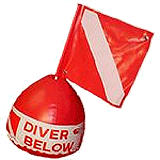A surface marker buoy, SMB, dive float or simply a blob is a buoy used by scuba divers, at the end of a line from the diver, intended to indicate the diver's position to people at the surface while the diver is underwater. Two kinds are used; one (SMB) is towed for the whole dive, and indicates the position of the dive group throughout the dive, and the other, a delayed surface marker buoy, DSMB or decompression buoy, is deployed towards the end of the dive as a signal to the surface that the divers have started to ascend, and where they are going to surface.[1] Both types can also function as a depth reference for controlling speed of ascent and accurately maintaining depth at decompression stops. Surface marker buoys are also used by freedivers in open water, to indicate the approximate position of the diver when submerged. They may also be used to support a catch bag or fish stringer by underwater hunters and collectors. A DSMB is considered by recreational scuba divers and service providers to be a highly important item of safety equipment,[2] yet its use is not part of the entry level recreational diver training for all training agencies, and there are significant hazards associated with incompetent use.[3]
A "safety sausage" or "signal tube" is a low volume tubular buoy inflated at or near the surface to increase visibility of the diver in the water.[4] A DSMB can be put to this service when necessary. When used by a diver to indicate their position, any of these may be described as a personal marker buoy.
Another function for a buoy deployed by a diver is to mark the position of an underwater point of interest. In this use the buoy is attached to the target until the position has been recorded, or until the marking function is no longer required. A wider range of equipment is used for this function, including the same equipment that would normally be used for marking the position of the diver. A problem associated with this use is how to hold the buoy in position at the point of interest but still be able to retrieve it from the surface.
- ^ Cite error: The named reference
Thomas 2017was invoked but never defined (see the help page). - ^ Cite error: The named reference
Lucrezi et al 2018was invoked but never defined (see the help page). - ^ Cite error: The named reference
Parsons and Darwentwas invoked but never defined (see the help page). - ^ Cite error: The named reference
Kollwitz 2015was invoked but never defined (see the help page).
